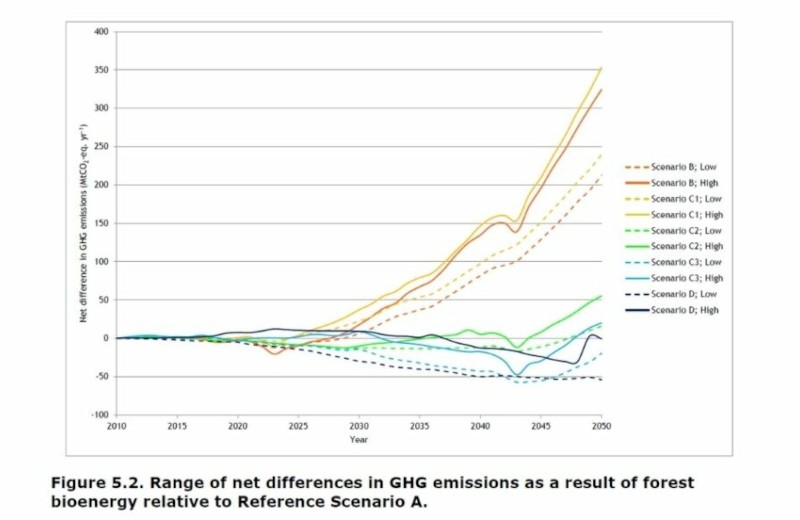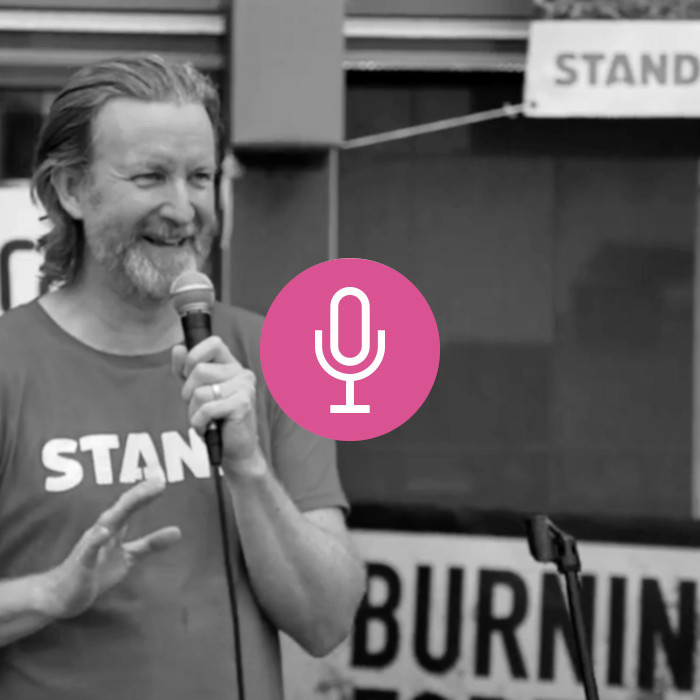Warning! This post is slightly techy (but everything is explained)
Background
The European Commission has recently launched a public consultation on the recast Renewable Energy Directive (2018/2001). As part of this, the EU as a whole will get the chance to review whether and how it should continue to treat wood from forests (aka “woody biomass”) as a renewable energy source. The inclusion of wood as a zero carbon fuel at all has always been controversial, with nearly 800 scientists writing to the European Parliament in 2018 (when the directive was being recast in full), arguing that ‘the solution to replacing coal is not to go back to burning forests, but instead to replace fossil fuels with low carbon sources, such as solar and wind’.
Many NGOs, including WWF and Fern (which focusses on forests), made strong representations to the Commission back in 2018, that it was time to de-rate wood as a zero carbon fuel. Since then, scientists attached to the European Science Academies (EASAC) – which advises on science policy – have also made increasingly strong warnings about ‘mismatches between science and policy in this area’. There has even been a case filed at the European Court of Justice, arguing that ‘sustainability protections in the EU’s recast Renewable Energy Directive (RED II) provide cover for continued logging, GHG emissions, and forest damage from biomass harvesting’ and a petition on YouMoveEurope has attracted the support of numerous environmental organisations and nearly 90,000 signatures.
The debate over whether wood biomass is renewable or not is, if anything, more relevant today than in 2017-18, with the EU looking to uprate the 2030 renewable energy target for the bloc; this could inadvertently lead to a much greater harvesting of wood both in the EU and beyond unless serious reforms are made – something to which the EU’s own Joint Research Centre has pointed towards with report in January 2021.
Analysis by researchers at the NGO Ember in 2019 found 67 coal-to-biomass conversion projects under various stages of development in Europe, which would triple wood pellet consumption, creating an additional demand of 36 million tonnes of wood per year. This would potentially require the felling of around 2,700 km2 of forest each year (around half the size of Germany’s black forest). EU member states are currently spending around €15 billion subsidising biomass burning, according to research from the National Resources Defense Council (NRDC) and the consultancy Trinomics.
But for this article, I want to revisit the findings of the Commission’s own independent advisers which was first published in 2015. The study, known in shorthand as the Bioimpact Project was compiled by a consortium of research institutions led by Forest Research (the research agency of the UK Forestry Commission) deployed Consequential Lifecycle Analysis (CLCA) to:
Quantify the global emissions…resulting from implementation of possible EU policies, represented by defined scenarios adopted for supplying and consuming energy, especially bioenergy, in the EU between 2010 and 2050.
For this article, I’ll be referring to a ‘supplementary analysis and interpretation’ published by Forest Research in 2018 for the European Climate Foundation – which relied on the same modelling data but attempted to be even clearer about the implications of the findings and also made recommendations for the “sustainability criteria” in the Commission’s (then) legislative proposal. The criteria that the EU finally adopted (which fell short of Forest Research’s recommendations) are contained in Article 29 of the Renewable Energy Directive (2018/2001). These are now back under the spotlight.
Complicating your view on Bioenergy
The authors begin by addressing a series of simplistic ‘positions’ often advanced by proponents of forest bioenergy. They begin with the ‘Virtuous Circle’ argument which will be familiar to anyone who has worked in and around bioenergy of any kind, but especially bioenergy derived from wood:
This argument essentially states that, “when trees are harvested from forests, new trees grow (or are planted) in their place, so there is no net impact on forest carbon stocks or sequestration”. (p.5)
And they provide an important qualifier:
In some situations, forest carbon stocks and rates of sequestration may be increased as a result of active forest management to produce more wood. However, there are many situations in which carbon stocks and possibly rates of carbon sequestration will be reduced as a result of increased wood production, even when the associated forest management is fully consistent with the principles of sustainability (p.6)
This means that “Sustainable forest management” (about which we hear a lot) does not guarantee in-and-of-itself an increase in forest carbon stocks. And this is often overlooked.
The authors go to some length to illustrate the problem, with reference to an influential 2016 study of Swedish forestry which they cite as an example of the ‘strengthening vigour’ argument. This argument goes beyond the “virtuous circle” argument by affirming that it is possible to increase annual average sequestration of a forest stand (sequestration refers to the CO2 removed from the atmosphere by plant respiration), by reducing the length of time (rotation) that a stand is left to grow before it is either thinned or cut down. They state:
There is some truth in this argument. If stands of relatively old or mature trees are felled and replaced by actively regenerated or replanted younger stands of trees, then within 10 to 20 years these younger stands will grow at faster rates than the older stands they replace, so they will sequester carbon at faster rates. [p.9]
That argument, in turn, is based on a general assumption that:
as populations of trees grow older, their rates of growth and carbon sequestration decline significantly when compared with younger trees (i.e. stands of trees less than approximately 50 to 70 years old in the context of temperate and boreal forests).
This argument is hotly contested in the peer-reviewed literature. But even if we accept the argument, as Forest Research point out, there are, often, many problems with its deployment in practice.
In the Swedish example, the authors of the 2016 paper argue that cutting down a particular stand of forest every 70 years (as opposed to every 100 years) increases mean rates of carbon sequestration over the rotation from 1.7 to 2.1 tonnes of carbon per hectare per year, respectively.
But, as Forest Research explain, there is a problem here, as even if we are increasing the annual sequestration rate of a given hectare of forest, we are not accounting for the loss of overall carbon stock in the forest. It is a question stocks and flows.
What [this] argument ignores is that carbon stocks in older/more mature forests are, by nature, much larger than carbon stocks in young forests. Increasing the rate of harvesting in older forests and replacing them with younger forests inevitably leads to a reduction in the average age of the trees in the forests, hence to a reduction in the average carbon stocks of the forests (potentially in soil and litter as well as in living trees). This is true even if the management of forests is to the highest standards of sustainability [emphasis own].
This can be seen in the table below, provided by the authors:
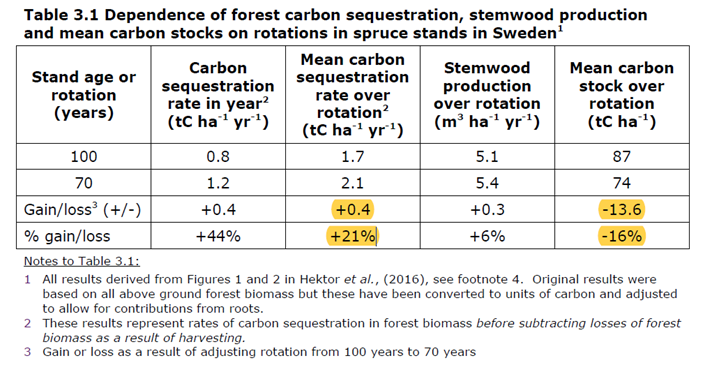
I have highlighted the most relevant figures. They show (on the left) that mean carbon sequestration rates can be going up every year, at the same time as overall carbon stocks (on the right) are going down. This is further impacted by the fact that overall harvesting rates are generally going up, not just being brought forward by a couple of decades.
“Fundamentally, a simplistic comparison of rates of growth and levels of harvesting is not a robust way to ensure low impacts of bioenergy sources on GHG emissions.” (p.15)
And this is just the impact on carbon stocks of removing wood from forests. When we are talking about the amount of carbon in the atmosphere, we have to look at what the harvested wood is being used for. There is a big difference between harvesting additional wood for – say – construction or for furniture (in which case the carbon can stay locked up for longer – although not always that much longer) and burning the wood for energy (even if you are substituting it for coal). If you are burning the wood, you are transferring the carbon from the forest to the atmosphere (to say nothing of the emissions involved in the pelletizing, drying and transporting it). The scientists affiliated to EASAC put this well in the context of switching from coal to wood burning in power plants.
When the forest is harvested and used for bioenergy, all the carbon in the biomass enters the atmosphere in one pulse. Moreover, since emissions of CO2 per unit of electricity generated are higher… the net effect is that the initial effect of the switch from coal is for emissions to INCREASE. That extra CO2 is only reabsorbed as forests regrow, so there is a time gap between releasing forest carbon and its reabsorption from the atmosphere – called the carbon payback period.
Scientific studies show this period to be very dependent on the source of the biomass. It can be short where unused residues from sustainably-managed forests are involved, but as soon as additional trees start being cut to provide the raw material for pellet mills, the payback periods lengthen considerably, and extend to decades or even centuries depending on the specific case.
The authors are clear that it doesn’t always have to be the case that forest carbon stocks decline, but they do say that these cases are “quite specific” (p.10) for the simple reason that older biomass is being replaced by younger. Take what you will from that. I suggest that it’s a diplomatic way of saying the equivalent of, “it is possible to maintain a healthy and balanced diet while drinking eight litres of beer a week, but these cases are “quite specific”. For these reasons:
“claiming higher carbon sequestration rates associated with intensified forest management overlooks the fundamental motivation for intensifying management, which is to utilize more of the potential of forests to produce wood.” (p.14)
Of course, there are many bioenergy companies who claim that they are not intensifying the harvesting of forests but merely dealing with the by-products and cast-offs of other, more high-value, industries, such as the furniture business. This doesn’t seem to chime with the photographic images of whole trees being taken to pellet mills but – even if it were true – these cases would be so niche that they would hardly constitute a basis for the huge ramp up of forest bioenergy envisioned and encouraged by the EU’s Renewable Energy Directive. And anyway, the aim is to encourage further forest growth and to discourage harvesting for any purpose. To return to my dietary analogy, if the biomass industry claims that the wood it uses would have been burnt anyway (a claim about which many are deeply sceptical) then this is tantamount to saying that feeding someone struggling with weight-gain a double cheeseburger is perfectly good for their health, as they would have eaten 12 chicken nuggets anyway. Fair enough, but such interventions are hardly those of a health guru. And yet biomass companies regularly go about claiming the status of green gurus.
As Forest Research say, even if we don’t burn the wood:
A significant body of relevant research shows that, even after allowing for the carbon retained in harvested wood products, in many situations the overall effect of “intensifying” forest management to increase wood production is a net reduction in carbon stocks [p.11]
What the scenarios say
Let us turn to the scenarios presented to European Commission in the Bioimpact report and recap on the remit and methodology.
The aim of the Bioimpact Project was to perform a qualitative and quantitative assessment of the direct and indirect GHG emissions associated with the different types of solid and gaseous biomass used in electricity and heating/cooling in the EU under a number of scenarios, focussing on the period to 2030 but with indicative projections up to 2050 (p2)
In the context of the Bioimpact project, the full assessment of any scenario for increased forest biomass supply and consumption needed to allow for the effects of intensified forest management on:
Forest carbon stocks and sequestration
Carbon physically sequestered in wood products
The potential savings of GHG emissions through the increased utilisation of wood as a source of bioenergy and materials, in place of fossil fuels and alternative (counterfactual) materials such as metals, plastics, bricks and concrete
Five scenarios were identified by a TIMES Integrated Assessment Model and presented alongside a reference scenario representing the continuation of existing EU decarbonisation policies beyond 2020 (or business as usual). The scenarios are described in more detail on pages 20-21 of the summary report. In short, they are as follows:
- Scenario A: (‘Reference’)
- Scenario B: (increased bioenergy compared to Reference Scenario)
- Scenario C1: (increased bioenergy, emphasising imported wood)
- Scenario C2: (increased bioenergy t emphasising the consumption of bioenergy from biofuel or energy crops and agricultural biomass grown in the EU
- Scenario C3: (increased bioenergy, whilst emphasizing the consumption of forest bioenergy, supplied from forests in the EU)
- Scenario D: (represented a situation in which the consumption of bioenergy as a renewable energy source would be de-prioritized after 2020 and required to decrease, against the reference scenario. The scenario made use of other low carbon solutions in place of much of the biomass in the reference scenario).
While all the scenarios achieved greenhouse gas (GHG) savings against the reference scenario, that is to be expected, given that ‘the setting of much more ambitious targets for GHG emissions reductions after 2020 in the decarbonisation scenarios, requiring the adoption of more ambitious climate and energy policies and implementation mechanisms compared to the Reference Scenario. The deeper GHG emissions reductions achieved in [the five new decarbonisation scenarios] identified by the model are related to changes in the types of bioenergy and non-bioenergy sources and conversion technologies that are represented in the energy mix in the different scenarios’. (p.29).
What is interesting is that all the GHG savings on the reference scenario come from technologies other than biomass (e.g. wind and solar energy). Which is why the scenario that achieves by far the greatest fall in GHG emissions is Scenario D (which sees biomass use deprioritised after 2020). The results can be seen in graph form:
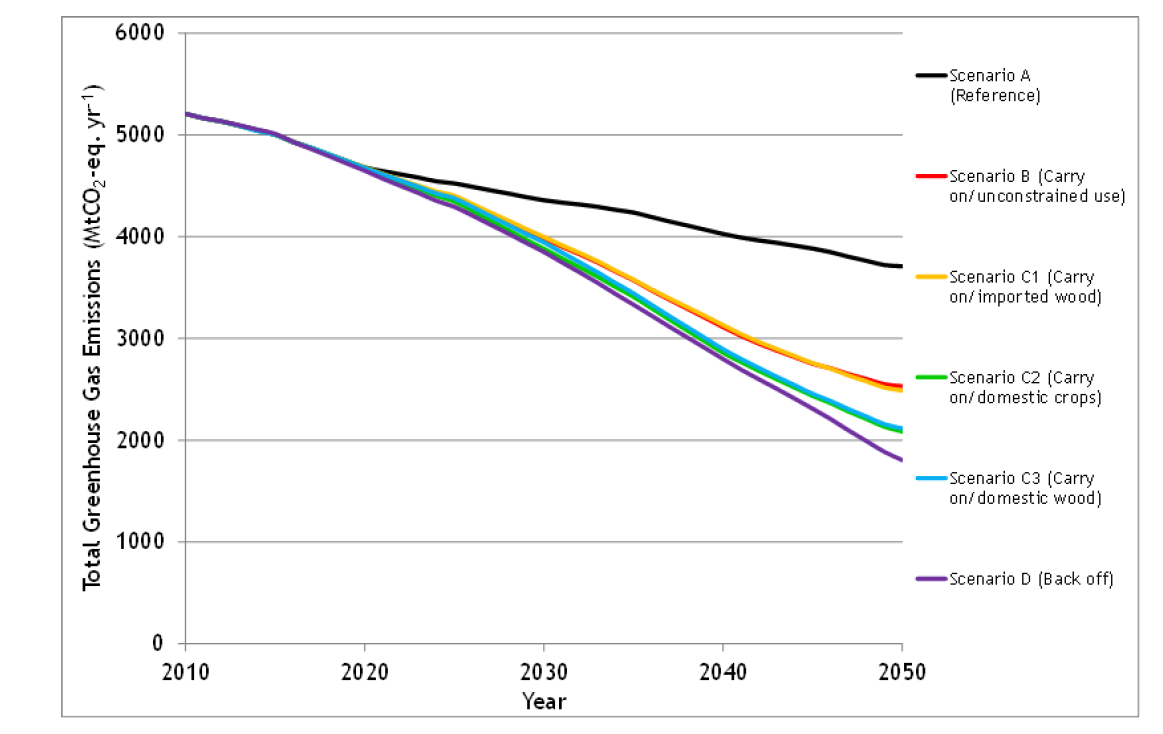
While the authors are open about the fact that the type of model employed in the study is designed to assess the contribution to GHG emissions of a combination of technologies, they do attempt to isolate the contributions made by each category of technology (“fossil”, bioenergy” etc). The results are striking and presented in Table 5.1 – (on page 30).
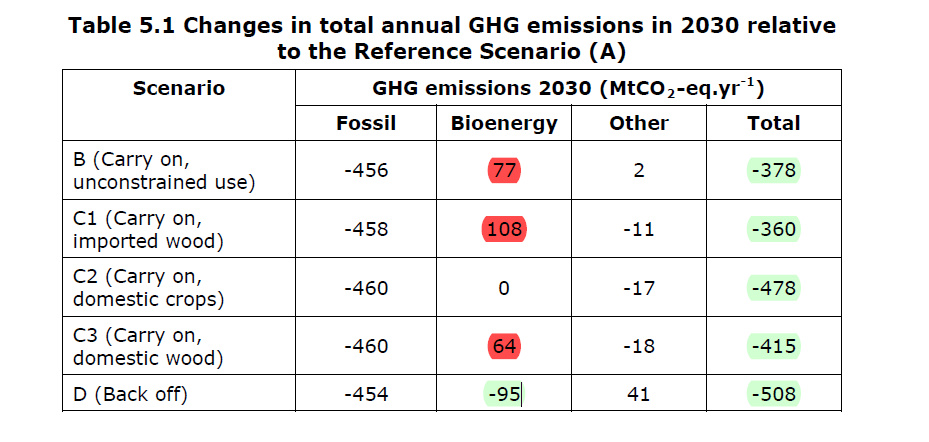
Again, I have highlighted the relevant numbers. The modelling shows that bioenergy is actually a contributor to net GHG emissions in three scenarios (despite the fact that the overall technological mix means that emissions across the economy fall overall). It is only in Scenario D, where there is a reduction in emissions from bioenergy – and that is because bioenergy use is curtailed. Moreover, the difference between the best-performing (D) and worst-performing (C1) scenarios is nearly 150 MtCO2e per year by 2030. That is nearly half the total emissions of a large emitter like the UK today and would represent a much greater proportion of EU emissions in 2030. When you consider that the difference in emissions between ‘backing off’ bioenergy and embracing imported bioenergy is over 200 MtCO2e per year – it is clear from the modelling that the authors are on firm ground in stating that:
There is a strong positive relationship between these emissions and the level of bioenergy consumption in the scenarios, compared to the Reference Scenario, particularly forest bioenergy consumption (i.e. the higher the levels of forest bioenergy consumption in the scenario the higher the GHG emissions). (p.31)
And this is something the European Climate Foundation (which commissioned Forest Research’s summary report) has recently sought to underline, in a statement issued in January 2021.
But the authors go further.
They try to isolate the contribution to EU emissions of continued use only of forest bioenergy – (that is bioenergy coming only from trees rather than, for example, agricultural residues or specific energy crops, which are included in the earlier scenarios). This allows them to observe an even greater divergence between the scenarios[3].
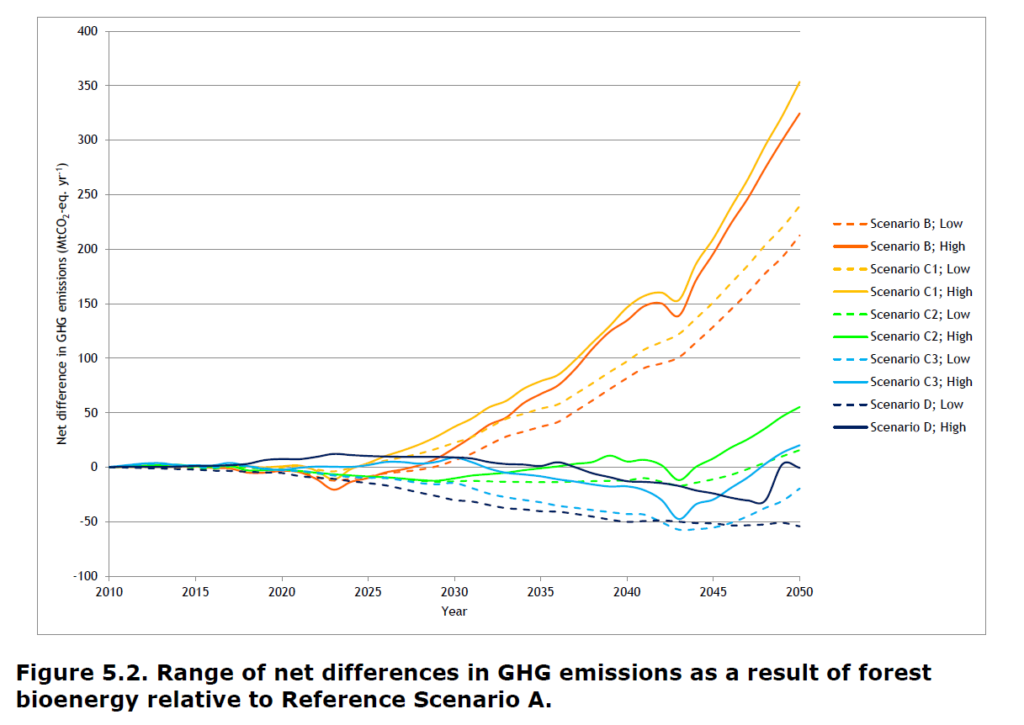
To be clear, this graph is showing the contribution that burning additional wood from forests will make to overall emissions when compared to a reference scenario (or business as usual) in the EU. Anything more than zero is bad, in that it is adding more GHG to the atmosphere than would have been expected under business-as-usual.
The findings are stark. They show that even a scenario relying on domestic forest biomass will (by 2050) turn into a net contributor of CO2. The other scenarios indicate huge contributions to EU emissions from additional forest biomass.
In reality, this graph deals a major blow to the low carbon status of forest biomass as a low carbon fuel. And there is something especially ironic about the fact that it is a company pursuing, in effect, scenario C1 (of embracing and expanding imports of forest biomass to the EU), Drax Group, that has most fully embraced the findings of this report.
The authors conclude thus:
It can be seen that in the scenarios where bioenergy use is unconstrained, or comes largely from imported wood (Scenarios B and C1), GHG emissions as a result of forest bioenergy increase over time, compared to the Reference Scenario A, and are significantly greater by 2040…
The scenario that emphasizes bioenergy supply from forests in the EU region
(Scenario C3) delivers GHG reductions as a result of forest bioenergy in the near term that are comparable to those that are estimated for forest bioenergy in Scenario D, which represents a strategy of backing away from bioenergy. However, after 2040, by which time the level of forest bioenergy consumption represented in the Carry on scenarios has become very high, the net GHG emissions as a result of forest bioenergy start to rise relative to the Reference Scenario.
What does it mean?
It is important to mention that – despite the starkness of their findings – the authors remain open to bioenergy’s use under tightly constrained conditions and they appear to incline towards the view that the bioenergy industry may provide a useful source of income to support land management practices that benefit the climate, by improving carbon sinks such as forests. There have been concerns raised about the additional energy-system costs attributed by the model to backing away from biomass, and this was something the European Commission emphasised in 2015.
Furthermore, the modelling from their “Synergistic” approach presents more favourable emissions figures for bioenergy in terms of emissions – although this modelling is not dealt with in detail in the summary report – the authors being clear that they are seeking to avoid presenting an optimistic set of assumptions to policymakers, sticking therefore – mainly – to what they call a ‘precautionary approach’. This seems wise.
In many ways, Forest Research’s statement on the risks associated with bioenergy policy remains the most assertive of the whole document:
Unless appropriate policy measures are taken to support sustainable bioenergy supply (in terms of impacts on GHG emissions), particularly in the case of forest bioenergy supply, a significant increase in bioenergy use in the EU is likely to lead to a net increase, rather than decrease, in GHG emissions being contributed from bioenergy sources. (p.59)
The measures that were included in the “synergistic” approach (e.g. afforestation and the restoration of marginalised or degraded land) could, the authors point out, be employed in the absence of the bioenergy industry although they do note that these would have to be paid for by some means – which is, of course, true. And it is welcome that, since the summary report’s publication, there has been much greater focus on biodiversity protection and finding funding for so called Nature Based Solutions to climate change, such as afforestation, reforestation and agroforestry. But the bioenergy industry is often seen as a threat to biodiversity and to carbon sinks; as the authors reiterate:
Putting aside the possibility of developing industrial-scale carbon capture and storage technologies, the only major global carbon sink over which humans can exercise some direct control is that due to land-based vegetation and soil. Hence, a key goal of the Paris Agreement could be missed if the intensification of biomass harvesting goes too far, without putting in place suitable safeguards to sustain land-based carbon stocks and potential future carbon sequestration. (p.15)
It is fair to say that both the Bioimpact Report and the Summary that was published in 2018 are complex documents. But, to me, their core findings of the severe risk that bioenergy poses to EU climate targets comes through and it is unsurprising that the findings of its precautionary scenarios caused controversy with bioenergy insider. The lead author, Robert Matthews, recently told the British journalist Hazel Sheffield that the graph above, (Figure 5.1) from the report ‘became a Pandora’s box of questions, comments, claims and counter-claims’.
There are certainly NGOs and other forestry experts who disagree with Forest Research’s specific recommendations for tightening the criteria for bioenergy in the Renewable Energy Directive, believing that now is the time to end all subsides for wood burning. They have a strong case. But the Forest Research report was intended mainly as a modelling exercise to guide decarbonisation policy. The pace at which energy-systems assumptions move has, of course, rendered some of the model’s 2015 findings outdated but this shouldn’t detract from the very real threat that bioenergy poses to forest and to the EU’s climate targets and, in that sense, ‘Pandora’s graph’ would be better named Cassandra’s graph.
[1](The difference between the emissions contributed by burning wood in each scenario depends on what energy source it is theoretically displacing, so the difference in emissions will be relatively higher if wood is replacing gas than if it is replacing a higher-emissions fuel like coal).
